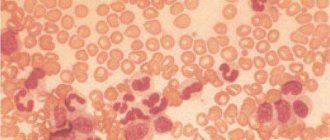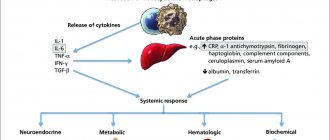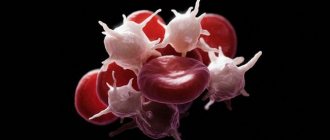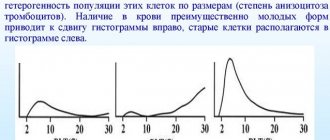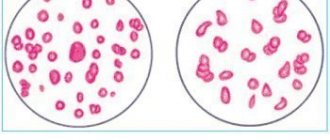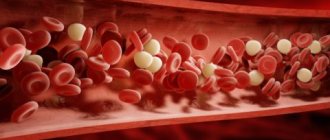General blood tests
10.25.201825.01.2019 Chernenko A. L. 1213 Views general tests, platelets
The level of platelets in the blood is assessed by performing a CBC (general blood tests). In order to determine the platelet level, venous blood is used (to obtain the most accurate results). However, taking blood from a finger is also allowed.
The level of platelets in the blood makes it possible to assess the state of the hemostatic system, determine the risk of bleeding or thrombosis, assess the effectiveness of anticoagulant treatment, etc.
An increased level of platelets can be observed against the background of temporary functional thrombocytosis, anemia of various origins, oncological pathologies, acute blood loss, erythremia, etc.
- 1 What do platelets show in a blood test?
- 2 Platelets - the norm for women by age and a table of their permissible concentrations
- 3 Normal platelets in men - table of values by age
- 4 When is a platelet level test prescribed?
- 5 How is a blood test for platelets and coagulation performed?
- 6 When can platelet levels in the blood increase?
- 7 When can a decrease in the number of platelets in the blood occur?
- 8 Treatment if low or high platelet levels are detected
Low levels of platelet cells may indicate that the patient has congenital thrombocytopenia, paroxysmal nocturnal hemoglobinuria, autoimmune pathologies, congestive heart failure, renal vein thrombosis, thrombocytopenia associated with infectious diseases, thrombocytopenic purpura, etc.
Normally, the platelet count in the blood may change slightly during the day. Also, in women, the normal platelet count may vary depending on the phase of the menstrual cycle and trimester of pregnancy.
What are they and their importance in the body?
Platelets are small (up to 4 μm), anucleate, round, colorless blood cells. They are 3 times smaller than red blood cells and are formed mainly in the red bone marrow from megakaryocytes. Instead of a nucleus, they have up to 200 granules of various structures.
Upon contact with a surface other than the endothelium, platelets develop about 10 processes that are several times their size.
These branches are important for stopping bleeding. The lifespan of platelets is about 4-7 days. Their destruction occurs mainly in the spleen and partially in the liver. The normal number of platelets is 180-320 thousand in 1 μl. When their number increases, thrombocytosis occurs, and when their number decreases, thrombocytopenia occurs.
The platelet count may fluctuate. Their number increases during intense physical activity, during stress, and during pain. Thrombocytopenia is a sign of some pathology. The main purpose of platelets is to participate in the process of hemostasis.
If the integrity of the vessel wall is violated, in order to stop bleeding, it is necessary to form a kind of “plug” that covers this damage. The main blood components involved in this process are platelets and fibrinogen.
When they interact, a platelet “plug” is formed, and the bleeding stops. Damage also causes vasospasm, which leads to a decrease in blood flow. Platelets first adhere to the subendothelium at the site of injury, and then their aggregation occurs.
The formation of a fibrin network, which stabilizes the “plug” and stops bleeding, occurs during the blood clotting reaction. It involves various plasma components, including platelets. The resulting clot dissolves at the last stage of hemostasis, when final healing of the wound occurs.
Platelets also protect the body from foreign agents. They have phagocytic properties and are capable of destroying the membranes of various bacteria. Peptide elements contained in platelets are released into the blood during injury and protect the body from microbes.
Deviations and their reasons
An upward deviation of the normal platelet count in the blood of women is called a platelet. A decrease in the number of cells is called thrombocytopenia.
Increased level
Thrombocytosis can result from:
- Physical overexertion (weightlifting, lifting heavy loads, intense running).
- Increased level of adrenaline in the blood.
- Acute and chronic infectious diseases (tuberculosis of the lungs and other organs, pneumonia, meningitis, viral encephalitis, hepatitis, gastroenteritis, parasitic and protozoal infections, systemic mycoses). Viruses and bacteria enter the body through aerosol, fecal-oral (food and water), contact and artificial (artificial) routes.
- Inflammatory diseases (collagenosis, sarcoidosis, Kawasaki disease).
- Operations (removal of the spleen).
- Tumors.
- Autoimmune diseases.
- Taking medications (corticosteroids).
- Anemia.
- Red bone marrow dysfunction.
- Cirrhosis of the liver.
- Severe blood loss.
- Osteomyelitis (a disease that affects bone tissue and bone marrow).
- Open injuries and wounds.
- Severe tissue necrosis.
- Primary thrombosis.
Reduced value
Deviations from the norm of platelets in the blood of women in the direction of decrease (up to 149*109/l or less) are caused by:
- Fanconi anemia.
- Congenital anomalies.
- Massive infusion therapy. Promotes blood thinning and relative thrombocytopenia.
- Vascular tumors (hemangiomas). With them, the platelet level drops to 170-150*109/l and lower.
- Splenomegaly (enlarged spleen). Possible against the background of sarcoidosis, tuberculosis, mononucleosis, alcoholism and portal hypertension.
- Lymphoma.
- Gaucher's disease.
- Autoimmune disorders. The body produces antibodies that damage red bone marrow tissue and disrupt platelet production. Causes include thrombocytopenic purpura, lupus erythematosus, multiple myeloma and autoimmune thyroiditis.
- Chronic hepatitis.
- HIV infection.
- Uncontrolled use of drugs (sedatives, gold drugs, diuretics, sulfonamides, antipsychotic drugs, anticonvulsants, Heparin).
- Administration of immunological preparations (vaccines and serums).
- Acute leukemia.
- Aplastic anemia.
- Irradiation.
- Conducting chemotherapy courses.
- Lack of iron, folic acid and cyanocobalamin in the diet.
- DIC syndrome.
- Viral diseases (adenoviral infection, chicken pox, measles, rubella, influenza).
- Burns.
- Alcohol abuse.
- Myelofibrosis.
- Evans-Fisher syndrome;
Important information: Where platelets are formed and destroyed in humans (which organ produces them)
A drop in platelets to forty or 30*109/l is life-threatening due to the high risk of bleeding.
Normal platelet count in women - table
The normal platelet count (PLT) is 180-320 thousand in 1 μl. Depending on the age and characteristics of the woman’s body, this level may vary. In newborns, the figure is 100-420 thousand in 1 μl. In children over one year old - from 180 to 320 thousand in 1 μl. The largest number of platelets is in adolescence; in girls aged 15 there are up to 340/350 thousand per 1 micron.
Platelets are the norm in women by age (table):
Table of normal platelet counts in women by age.
During menstruation, the figure can drop to 150 thousand per 1 μl. During this period, blood clotting is reduced to ensure complete rejection of the endometrium in the uterus. In pregnant women, the platelet count drops to 150 thousand in 1 μl.
During this period, there is an increased blood flow to the fetus, and the woman’s body does not have time to produce new cells in sufficient quantities. After childbirth, platelet levels recover on their own. If the platelet level is less than 140 thousand per 1 μl, then pregnant women may experience bleeding during childbirth.
Table of average platelet values in women in the normal range, determined by age:
The platelet count may change throughout the day. At night the figure is slightly lower than during the day. The level also varies depending on the time of year. The fewest platelets are in the spring.
What are platelets?
To understand the full role of platelets in human blood, it is first necessary to correctly formulate their characteristics. Platelets are called blood cells that are round or oval in shape with a flat surface. The lifespan of human platelets is 6-11 days. After this time, some cells are destroyed, while others are produced by the bone marrow. To understand what platelets are responsible for, it is worth understanding their capabilities.
In the human body, blood performs a transporting function - it carries oxygen and useful substances to all organs and systems. In addition, its elements fight harmful microorganisms. Platelets affect the rate of blood clotting, as they tend to attach to each other or to pathogenic microorganisms. These elements take part in protecting the body, but often they cause the formation of blood clots.
The vital supply of platelets varies depending on age. The largest amount of these elements is in children; in adults, production decreases over the years, as the bone marrow slows down. The importance of platelets is so great that scientists have calculated the norm for each age group.
Indications for testing
Platelets (the norm for women by age - the table is attached) are detected using an analysis - this is a standard procedure that is prescribed to all patients. As a result of the study, deviations from acceptable values can be detected and pathology can be identified.
A general or biochemical blood test is prescribed. Based on the data obtained, it is possible to understand how the body functions and what disorders exist. A general blood test measures hemoglobin, leukocytes, red blood cells, and ESR. The platelet level is also assessed.
A general platelet test is prescribed:
- to identify inflammatory processes in the body;
- for blood diseases;
- for allergies;
- in case of a failure in the immune system;
- during pregnancy;
- with varicose veins;
- for problems with blood clotting.
Platelet counts should be checked in the following cases:
- functional liver disorders;
- suffered a heart attack or stroke;
- before treatment with anticoagulants;
- during menopause.
The study is carried out to identify violations in the work of:
- of cardio-vascular system;
- Gastrointestinal tract;
- respiratory organs;
- urinary system.
A blood test for platelets is carried out if there is a suspicion of a malignant tumor, disruption of the endocrine system, or immunological disorders. The analysis can also be done for prevention in order to detect pathological processes in the body.
How to prepare for donating blood for platelet determination
A blood test for platelet levels is taken in the morning on an empty stomach. During the day before the test, you must stop eating fatty and fried foods, alcoholic beverages, and smoking. Sweets, taking certain medications (aspirin), carbonated water, coffee or tea with sugar can change the platelet value.
Before the study, you should avoid excessive physical and emotional stress. In emergency cases, blood sampling is carried out 1-2 hours after eating.
The result of the analysis may be influenced by factors such as:
- the patient’s condition (physical fatigue, alcohol intoxication, severe stress);
- quality of reagents;
- menstruation, pregnancy, lactation.
Blood is usually collected from a finger. Some laboratories take material for examination from a vein. A better analysis is obtained from venous biomaterial.
When and how to get tested
The material for determining the formed elements is capillary or venous blood. When donating blood, you must adhere to the following rules:
- do not eat in the morning before sampling (blood is donated on an empty stomach);
- stop smoking and drinking alcohol several days before the study;
- do not be stressed or worried (this may affect the results);
- don't overexert yourself.
No special training is provided. Platelet counting is an integral part of a general (clinical) blood test. Most often, the material is taken from a finger. To do this, you will need a scarifier (a metal needle for piercing tissue), a labeled test tube and a capillary. First, the nurse prepares the equipment.
Then the puncture site (the pad of the ring finger of the left or right hand) is treated with alcohol. After this, the skin is pierced to a depth of about 5 mm. The first drop of blood is not suitable for analysis, so it is removed with a cotton swab. Subsequent drops are collected with a glass tube and poured into a test tube. After collecting the required volume of blood, a cotton swab with an antiseptic is applied to the finger.
Important information: What do low platelets in the blood indicate during pregnancy (increasing foods)
Biological material is often taken from the cubital vein. Immediately before inserting the needle, the tissue is tightened with a tourniquet. It is placed on the forearm of the non-working hand over clothing. A woman should work with her fist to better pump blood. The resulting material is sent to the laboratory, where a general blood test is performed.
The level of platelets in the blood is most often determined by the counting method in the Goryaev chamber. The easiest way is to use analyzers. The blood is diluted, a smear is prepared (stained) and placed in Goryaev’s chamber. Using microscopy, the doctor counts the cells. In the blood, platelets are located separately or next to red blood cells. They are much smaller than red cells, do not have nuclei and are colored bluish. The results are written in numerical form with a factor of 10 to the ninth power per 1 liter.
What tests are taken to determine platelets?
To determine the platelet count, a general study is prescribed. Blood is taken from a finger. If deviations from the norm are detected, the woman must undergo an additional study - a coagulogram analysis. In this case, blood is taken from a vein. The minimum required volume of biomaterial is 1 ml.
Coagulogram analysis is carried out:
- before surgery;
- during pregnancy (if there is a risk of premature placental abruption);
- with a tendency to form blood clots;
- to control the level of blood clotting during treatment with anticoagulants;
- in case of liver dysfunction, vascular problems, after a stroke or heart attack;
- with long-term use of hormonal medications and contraceptives;
- if extensive bleeding begins.
The main indicator of a coagulogram is the coagulation period, that is, the period of time during which a dense clot is formed that stops bleeding. For material from capillaries, this value should be from 30 seconds to 3 minutes, and for venous material – up to 10 minutes.
During the study, the prothrombin index is determined. This is a deviation in the patient's blood clotting time from the normal value. Normally the error is about 7%. Too high a reading indicates liver disease. During pregnancy, it rises for physiological reasons, which is in no way connected with any disorder.
Reasons for the increase
The role of platelets in the body is quite significant, so a deviation from the norm may indicate the development of a number of serious diseases. In combination, an increase indicates the development of thrombocytosis, when colorless bodies are produced above normal. This situation may be affected by the development of:
- tuberculosis;
- toxicosis during pregnancy;
- liver or kidney cancer;
- erythrocytosis;
- myeloid leukemia;
- lymphogranulomatosis;
- anemia;
- hemolysis;
- meningitis;
- hepatitis A.
Important! Removing the spleen and taking corticosteroid medications can reduce the effect of platelet mass.
The CBC, where thrombocytosis is diagnosed, should undergo a detailed study. The patient must repeat the analysis, but with a more comprehensive biochemical spectrum. Platelets are produced every 5-10 days, so their number should be monitored regularly. Due to excessive amounts of these elements, the risk of stroke or heart attack increases sharply. Concomitant diseases may include hypertension and coronary heart disease. Treatment in this case is based on taking anticoagulants, which reduce the clotting function.
In addition to reducing the number of flat bodies, doctors use immunomodulatory treatment to reduce the aggregation of these substances. If necessary, anti-inflammatory drugs may be included in therapy.
If a malfunction of the bone marrow occurs, the production of these substances begins to be uncontrolled.
Important! The number of platelets in the CBC of a person who has experienced severe blood loss increases. This occurs due to the fact that the body’s protective functions compensate for the loss to the maximum. After severe bleeding, the number of flat elements may be below normal only in the first hours. Within 24 hours, platelet cell levels increase.
Platelet counts should be strictly monitored in people who are overweight, have had surgery, or have had a serious injury. All this can cause the development of secondary thrombocytosis. In the analysis table, an increased number of colorless elements should be further examined. Doctors often recommend:
- undergo an ultrasound examination of the abdominal and pelvic organs;
- take a blood test for C-reactive protein and iron levels;
- take a general urine test;
- repeat the platelet test three times with an interval of 4-5 days.
Such activities will help clarify the diagnosis.
Methods for determining platelets in blood
Platelets (the norm for women by age - table above) are determined based on a blood test. A general analysis is carried out, its result is compared with the norm, thus obtaining the desired indicator. The Fonio method is used as a basis.
Blood is taken from a finger, mixed with a reagent and examined under a microscope. The study can be carried out over the next 2 hours, but the patient usually receives the result the next day.
The Fonio analysis table includes the following values:
- PLT – quantitative composition of platelets in the body (depending on gender and age);
- MPV —mean blood cell volume;
- PDW —distribution area;
- PCT is the percentage of blood cells relative to the total blood volume.
The rate of platelets per 1 thousand red blood cells is calculated. This ratio reduces the risk of detecting pseudothrombocytosis. First, the total number of red blood cells in the smear is calculated, then the indicator is multiplied by μl of blood. The obtained value is compared with the quantitative composition of platelets.
To carry out analysis using the Fonio method, you need a 14% solution of magnesium sulfate and a 2.6% solution of sodium ethylenediaminetetraacetate. Reagents are taken using a Panchenkov capillary. A blood test performed using this method has a high level of accuracy.
Advantages of the Fonio study:
- the analysis can be performed at any time after blood collection;
- the laboratory technician sees the cells in the smear;
- simple calculation formula.
To study platelets, venous blood is taken in Goryaev’s counting chamber. Isotonic sodium chloride solution is used as reagents. A drop of blood is placed on the ground glass of the chamber. The platelet count is counted under a microscope using a phase contrast device.
Pct - what is it, role and functions in the body
PCT (the abbreviation used to refer to the results of a platelet test) illustrates the status of the portion of the total blood volume that contains platelets. This is an indicator whose level in the analysis is most often determined in an automated way rather than by manual calculation. Its main role is to prevent the progression of dangerous diseases.
The most common among them are:
- thrombosis;
- stroke;
- cerebral hemorrhage;
- causeless internal bleeding.
The criterion under consideration helps to determine:
- How prone a particular person’s body is to bleeding . In cases of obvious predisposition, doctors usually prescribe corrective medications in order to minimize the existing risk.
- The degree or speed of the thrombus formation process . Based on blood clotting, we can predict how likely the patient’s body is to develop a vascular blockage that prevents free blood circulation.
Due to the objective importance of the result obtained, accurate platelet counting, provided by advanced technologies, is more popular than manual counting.
PCT in a blood test is the number of platelets per liter!
If there is insufficient or excessive number of platelets in the body, a person suffers from:
- frequent headaches, migraines;
- changes in skin color of the extremities;
- causeless bleeding (most often from the nose);
- apathy, drowsiness;
- decreased performance;
- severe itching on the fingers or toes;
- pain in the kidneys or liver;
- enlargement of the liver or spleen.
Studies of platelet characteristics using a hematology analyzer
Laboratory studies of platelets are carried out not only using the old methods (staining and counting their number on glass), but also using a hematology analyzer. Thanks to this modern device, quantitative and qualitative blood analysis is carried out.
Using a hematology analyzer, the mean platelet volume (MPV) is determined. The equipment can show the result in the form of a histogram, where old and new cells are displayed.
The increase in MPV occurs:
- with anemia after bleeding;
- thrombocytopenic purpura;
- macrocytic thrombodystrophy.
A decrease in MPV is observed:
- with inflammation;
- pregnancy;
- iron deficiency anemia;
- tumors;
- for blood clotting disorders;
- liver and kidney pathologies;
- heart attack;
- hypercholesterolemia.
Using the analyzer, an indicator of cell heterogeneity is calculated - the degree of change in platelet size (PDW). Its deviations from the norm indicate the development of an inflammatory process, helminthic infestation, anemia, and cancer.
Decoding the results
Platelets - the norm for women by age (the table contains minimum and maximum values) - should be in the range of 180-320 × 109 units. There is no separate blood test for platelets. Its indicator is assessed when taking biomaterial for general analysis.
In addition to platelet level (PLT), thrombocrit (PCT) is measured. It shows the proportion of whole blood volume occupied by platelets. The normal thrombocrit is measured as a percentage. The acceptable rate is 0.1-0.4%.
What do the analysis values indicate:
A blood platelet test is a diagnostic test. Its goal is to identify pathology. If the platelet count is higher or lower than normal, some disease develops in the body.
If there is an imbalance between the formation of new platelets and the disposal of old ones, then the woman develops pathologies that manifest themselves in increased bleeding or, conversely, in a tendency to form blood clots. A decrease in the number of blood platelets is observed with thrombocytopenia. An increase in the number of platelets occurs with thrombocytosis.
Both of these phenomena indicate disturbances in the body and are a reason to consult a doctor.
Content standards and units of measurement
The number of platelets in the CBC must be strictly controlled, so the level of these elements is checked during analysis in both adults and children. The number of such plates is calculated in thousands per unit μl.
Cells under a microscope
How to donate blood for platelets? What do the tests say? Normally, the number of platelets in the blood should be:
- For males – 200-400 thousand units/µl,
- Platelet norms in the CBC for females are 180–320 thousand U/μl. At the time of menstruation, this figure may drop to 75-220 thousand U/μl. During the menstrual cycle, the female body changes not only the percentage of hematopoietic elements, but also hormones. During menstruation, such a change is considered normal.
- The norm of platelets in the blood for children takes into account age. For newborns – 100–420 thousand units/μl; for children from 14 days to one year – 100–420 thousand U/μl; from 1 to 5 years – 180–380 thousand U/μl; 5-7 years – 180–450 thousand units/µl.
- For pregnant women, this figure can drop to 100-310 thousand U/μl.
If a low or high level of platelets in the blood is noticed, then it is better to carry out repeated studies at least 2 times a year. Any changes in platelet count may increase the risk of blood clots or bleeding.
Reasons for increased indicators
There are factors that influence changes in normal platelet levels. With elevated levels, the patient develops thrombocytosis. This condition increases the risk of blood clots and blood vessel blockages. This condition can lead to a heart attack or stroke.
Causes of increased platelets:
- splenectomy;
- development of the inflammatory process;
- different types of anemia;
- postoperative period;
- malignant tumor;
- erythremia;
- exercise stress.
Important Features
Platelets are cells that are shaped like small plates. Their main task is considered to be protection against blood loss. When a vessel is damaged, platelets move to the painful area. They are held together, creating a barrier that protects against bleeding.
In addition to this function, platelets are needed for the liquid state of the blood and the dissolution of existing blood clots, so regular analysis is required. Increased and decreased indicators negatively affect human health. In case of deviations, it is necessary to follow the doctor’s recommendations, which will help normalize the cell level.
Reasons for low performance
Platelets - the norm in women varies by age (the table will tell you) - can decrease, deviating from normal values. This condition is called thrombocytopenia. In patients, blood clotting is impaired. Any wound can lead to prolonged bleeding that is difficult to stop.
Reasons for low platelet levels:
- autoimmune pathologies of the blood system;
- hemophilia;
- acute liver damage;
- thyroid diseases;
- bone marrow diseases;
- drug-induced thrombocytopenia;
- infectious diseases;
- aplastic anemia;
- DIC syndrome;
- thrombosis.
Patients with thromocytopenia have long and heavy periods, bruises and bruises appear on the body for no reason. Wounds and cuts take too long to heal. Gums and nasal passages often bleed. Platelets may be low in premature babies.
Medications
There are many medications that help regulate the level of platelets in the blood. If an increase or decrease in the indicator is caused by some pathology, then it is necessary first of all to treat the disease due to which it deviated from the norm.
Medicines to raise platelet levels:
- hormonal agents – Prednisolone, Dexamethasone;
- to stop bleeding - Dicynon;
- natural preparation – Sodecor;
- for internal hemorrhages - Vikasol;
- for a rapid increase in platelets - Thrombopoietin;
- vitamin C.
Medicines to lower platelet levels:
- Aspirin;
- Thromboass;
- Livarudin;
- Argatoban;
- Aspecard;
- Bivalirudin.
How to return platelets to normal?
The platelet count in the analysis does not always please patients, since the results are often far from ideal. It is common for a person to worry about his health, so he resorts to self-medication. It’s worth noting right away that platelet formation is a complex process, so you shouldn’t influence it without medical help. Self-medication in this case can lead to internal bleeding.
Platelets and blood coagulation are two interrelated concepts that cannot function without each other, so only the attending physician should correct these processes.
To give up smoking
To return indicators to normal levels, first of all, you need to overcome the causes of deviations. When the disease is accurately diagnosed, then with time of recovery these indicators should return to normal.
Let us highlight several rules that will help increase the number of flat blood elements:
- Minimize physical activity.
- Stop smoking.
- Remove stress factors from life as much as possible and reduce emotional arousal.
- Women should not engage in heavy physical work during the menstrual period.
- Eat healthy food, consume more: greens, nuts, white meat, bananas, vegetables, berries, sea fish.
- Remove alcohol, spicy foods, red grapes, and seaweed salads from your diet.
- Do not take antibiotics or antidepressants. Only a doctor can prescribe medications.
- Consume foods that are rich in vitamin B12, A, and C.
- Do not engage in strenuous workouts in the gym, which can lead to injury.
Platelets in the blood do not live long, so their excessive production is fraught with complications. To reduce them, you need to follow the following recommendations:
- Consume less nuts, bananas, lentils.
- Eat more garlic, onions, ginger, beets, olive oil, tomatoes.
- To lower your platelet count, you should drink 1-2 cups of green tea per day.
- Drink at least 2 liters of water per day.
Blood thinning is recommended for people with cardiovascular diseases. Special attention is paid to the level of platelets in the blood of an adult patient in case of overweight and diabetes mellitus.
Only the attending physician should decipher the results of the OAC. Several doctors can figure out why there are deviations, but in severe cases it is worth seeking help from a hematologist. Decoding is not a simple comparison of results; basically, the doctor makes a conclusion based on a comprehensive examination of the patient.
Diet
You can increase or decrease your platelet levels with diet. To do this, you need to eat healthy foods and avoid harmful ones. Medical nutrition can only be used as an auxiliary therapy. The main treatment should be medication.
Diet to increase platelet levels:
- red meat;
- buckwheat;
- river/sea fish;
- eggs;
- cheese;
- beef liver;
- meat broths;
- pates;
- salads from cabbage, beets, carrots, bell peppers, nettles with sesame oil;
- bananas;
- parsley dill;
- rowan berries;
- green varieties of apples.
If thrombocytopenia occurs, you should avoid olive oil, raspberries, and ginger. These products thin the blood. It is not recommended to drink wine and other alcoholic beverages. You should reduce your coffee consumption.
Diet to lower platelet levels:
- seafood;
- consumption of large quantities of water;
- green tea;
- olive and linseed oil;
- grapes, citrus fruits, blueberries, cherries, cranberries, lingonberries;
- cocoa;
- ginger;
- celery;
- onion;
- garlic.
If platelet counts are elevated, you need to eat more fresh fruits and vegetables. You should avoid fatty and fried foods. It is advisable to eat less protein foods.
Folk remedies
You can also adjust your platelet levels at home. Treatment with folk remedies should be under the supervision of the attending physician. Tinctures and decoctions are an addition to the main treatment; they cannot replace drug therapy.
Recipe for increasing platelets from nettle:
- nettle juice – 50 ml;
- milk – 50 ml.
Squeeze the juice from fresh nettles and add milk to it. The composition is taken 3 times a day before meals. Duration of admission – 14 days. The mixture is prepared before use; the medicine cannot be prepared for future use, it quickly loses its properties.
Chokeberry improves blood viscosity well. It is recommended to consume 50 berries every day for 3 weeks. The course of treatment cannot be extended.
Recipe for lowering platelet count with garlic:
- garlic – 1 head;
- vodka – 200 ml.
Garlic is poured with vodka and left in a dark place for a month. After a while, grind it through a sieve. Take half a teaspoon 2 times a day.
Recipe for reducing platelets with ginger:
- ginger – 30 g;
- honey – 30 g.
Ginger is crushed. Mix with honey. One spoon of the mixture is diluted in a glass of water and taken 2 times a day. If a blood test shows a deviation from the table norm in the number of platelets - an increased or decreased level - you should undergo a course of treatment. People with thrombocytopenia, regardless of age, should avoid traumatic sports.
You should also avoid alcoholic beverages, vinegar, and certain medications (Aspirin, Analgin). If your platelet count is elevated, you should follow a blood thinning diet and drink as much water as possible. It is especially important to monitor platelet levels in women during pregnancy.

